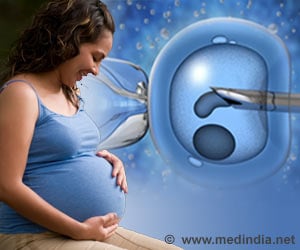In-vitro fertilization may boost birth defect risk in newborns, according to new research.

A new research has linked In vitro fertilization (IVF) to increased risk of birth defects. Using IVF can lead to birth defects, particularly those of the eye, heart, reproductive organs and urinary systems.
According to the study, despite increasing use of IVF in the United States, associations between birth defects and IVF are poorly understood. Management of birth defects comprises a large part of pediatric surgical care and demands significant health care resources.
According to the study, despite increasing use of IVF in the United States, associations between birth defects and IVF are poorly understood. Management of birth defects comprises a large part of pediatric surgical care and demands significant health care resources.
While the risk is considered statistically significant, the researchers who presented the study at medical conference over the weekend note the overall risk of birth defects remains low. However, the association between In-vitro fertilization (IVF) and birth defects may warrant a conversation with a doctor for parents considering fertility treatments.
- Fertility doctors back freezing eggs, insurers next?
- Using yoga for fertility
- In-vitro fertilization allows grandmother to give birth to grandchild
"For parents considering in vitro fertilization or other forms of assisted reproductive technology, it is important that they understand and discuss with their doctor the potential risks of the procedure before making a decision," study author Dr. Lorraine Kelley-Quon, a general surgery resident at Ronald Reagan UCLA Medical Center, said in a press release.
IVF is the joining of a woman's egg and a man's sperm outside of the body. It is a type of assisted reproductive technology (ART) used to treat many causes of infertility including advancing maternal age in women, damaged or blocked fallopian tubes, endometriosis or male fertility problems such as decreased sperm counts.
The procedure typically starts with fertility drugs to stimulate egg production (women produce one egg each month), the eggs are then removed from the woman's body where they are inseminated with sperm. Once the egg becomes fertilized, it's called an embryo, and doctors will place it in the woman's uterus about three to five days after fertilization.
Other types of ART include artificial insemination and ovulation induction.
The new study, presented Oct. 20, at an American Academy of Pediatrics conference in New Orleans, looked at nearly 50,000 infants born in California, comparing those born with IVF and those conceived naturally. California has the highest rate of IVF use in the United States, according to the researchers.
They identified 3,463 infants with major birth defects among 4,795 infants born after IVF and 46,025 naturally conceived infants with similar maternal demographics. That amounts to nine percent of infants born to IVF having a birth defect, compared with 6.6. percent of those conceived naturally -- about 1.25 times a greater risk.
Birth defects of the eye, heart and urogenital system (consisting of reproductive organs and urinary tract) were also found to be more common in children born with IVF.
"Our results imply that there may be factors inherent in assisted reproductive technology that increase the likelihood of birth defects," Kelley-Quon toldMedpage Today.
Risk of birth defects after non-IVF fertility treatments were not found to be significant, meaning they may be caused by chance. The findings are considered preliminary since they were presented at a conference and not published in peer-reviewed journal.
 Dr. Edward Illions, an associate professor of clinical obstetrics, gynecology and women's health at Albert Einstein College of Medicine in New York City, told HealthDay the findings are not surprising based on existing research dating back to the 1980s.
Dr. Edward Illions, an associate professor of clinical obstetrics, gynecology and women's health at Albert Einstein College of Medicine in New York City, told HealthDay the findings are not surprising based on existing research dating back to the 1980s."The bottom line is we're still not sure what component of the process is giving the risk," Illions said. "Is it something we're doing in the lab -- the culture media, which contains a lot of synthetic growth factors and protein supplements? The fertility medications? Is it the nature of the illness itself -- people with ovulatory dysfunction? Those are all potential confounding factors," he explained.

0 comments:
Post a Comment